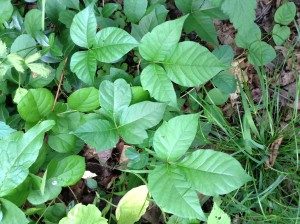Plant Allergic Contact Dermatitis – Poison Ivy
 As we spend more time outside this summer, let’s talk about plant-associated rashes including poison ivy. This post will address ALLERGIC Contact Dermatitis from plants and the next one will address IRRITANT Contact Dermatitis.
As we spend more time outside this summer, let’s talk about plant-associated rashes including poison ivy. This post will address ALLERGIC Contact Dermatitis from plants and the next one will address IRRITANT Contact Dermatitis.
Allergic contact dermatitis is most commonly seen with poison ivy, but there are a number of other plants that can also contain contact allergens that cause a rash. Here are four tips for dealing with poison ivy and other plant-associated contact dermatitis:
1-The rash occurs as a direct result of exposure to the oils from the plant. Poison ivy contains an oil allergen called urushiol. The allergen is the same in poison oak and poison sumac. DERM MD TIP: It is very difficult to tell what plant or other allergen caused the rash just by looking at the rash itself. Just a reminder that poison ivy has 3 leaves so remember the old adage, “leaves of three, let it be!” Poison oak has 3 to 5 leaves, and poison sumac has 7 to 13 leaves on a branch.
2-The skin absorbs the urushiol oil of poison ivy and other allergens quickly, so wash immediately with soap and cool water if you know you have come in contact with a poisonous plant. The oil can remain for some time on clothing, tools, boots, gloves and can be carried in by pets. As a good habit, remove all clothes when coming in from working or playing in the yard. I try to turn my work clothes and gloves inside out, especially if I am not putting them in the washer immediately. Otherwise, I could contact the oils again when doing the laundry. DERM MD TIP: You only get a rash from initial contact with the oils of the “poisonous” plant. You cannot spread the rash on your own body by scratching it. The blisters and rash are not “contagious”. The rash develops at different times, on average 1-7 days after exposure to the oils. The development of the rash depends on the “dose” of the oil received and the thickness of the skin where it contacts.
3-Using products like Ivy Block are not foolproof. There are a number of over-the-counter products that contain bentoquatam. This is a chemical that cuts down on the absorption of the oils by the skin. DERM MD TIP: Wear long pants and long sleeves as much as possible outside. The side benefit is avoiding sun and insect exposure. I like the lightweight water-wicking exercise or hiking clothes with UPF>30.
4-If you do develop poison ivy or other allergic contact dermatitis, it is best to treat it topically unless it involves an orifice (mouth, nose, eyes, ears, genitalia) or covers a large part of the body. It is NOT a good idea to go to urgent care and get a steroid shot or a Medrol Dosepack. Here’s why… If we consider the day you come in contact with the oils of the plant Day ZERO, it usually takes about 4 days for the rash to get bad enough for you to the doctor. Once there, if prescribed a 6-day course of medicine, you are out of medicine at Day 10. DERM MD TIP: Poison ivy rash can often take 21 days or more to run its course and in my experience the reaction peaks at day 10-14. So, with a 6-day course of medicine, patients run out of medicine at the PEAK. For severe cases, I often recommend a 15-day tapering dose of oral prednisone to get patients on the other side of that peak.
POISON IVY, POISON OAK and SPOTTED WATER HEMLOCK are seen in all continental US states.
For more details, watch the informational video from the AAD.
Or check out their online reference for Poison Ivy.